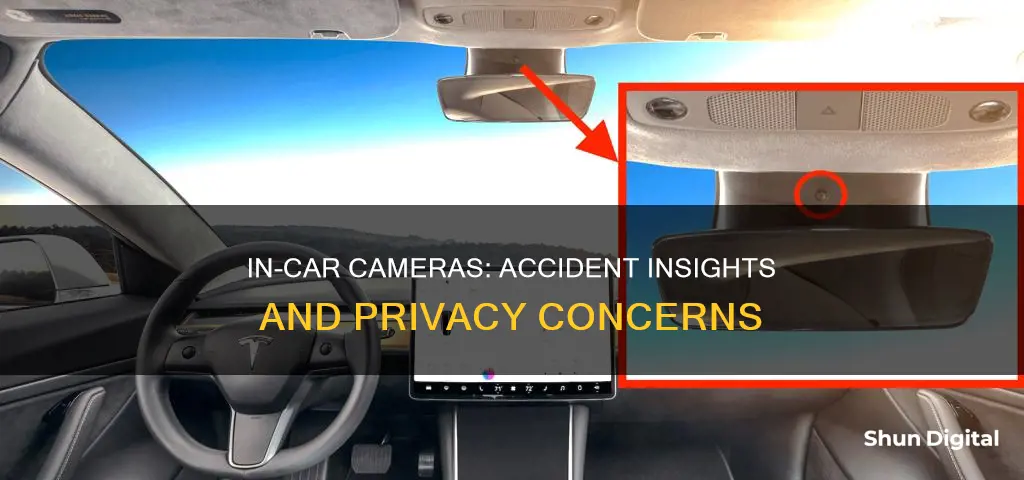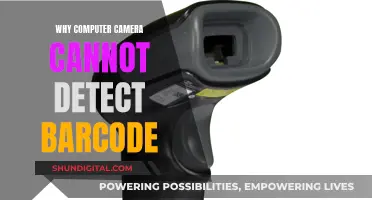
In recent years, car manufacturers have started to include cameras in their vehicles, with some models offering up to five cameras placed throughout the car. These cameras are used for a variety of purposes, including improving vehicle security, safety, and convenience. While some cameras are installed externally to enhance the driver's field of vision and eliminate blind spots, others are placed inside the car. Interior cameras are often used to monitor the driver's awareness and can be utilised to combat drunk driving by analysing the driver's face and behaviour. Additionally, these cameras can record footage that could be useful in the event of an accident, functioning as a type of dashcam.
What You'll Learn
- Dash cams can be used to record accidents and adverse events
- Cameras can be used to monitor the driver's awareness and behaviour
- In-car cameras can be used to improve vehicle security
- Cameras can be used to provide a bird's-eye view of the vehicle's exterior
- Recordings can be used for customer support, safety reasons, and vehicle maintenance

Dash cams can be used to record accidents and adverse events
Dash cams are small video cameras that can be installed on a car's windshield or dashboard. They are used to capture real-time footage of road events, providing an accurate visual account of what happens during an accident or adverse event. This footage can be crucial in determining fault and assigning liability in the event of a collision.
Dash cams are available from aftermarket manufacturers such as Garmin, Nextbase, Nexar, and Thinkware, and can also be factory-installed in some vehicles. These factory-installed dash cams often serve dual purposes, acting as the eyes of onboard safety systems like lane-departure assist and forward-collision warning, while also offering recording options for drivers.
The use of dash cams as evidence in car accident cases is becoming increasingly common and can have a significant impact on the outcome of insurance claims and legal proceedings. Dash cam footage can provide unbiased visual evidence of the events leading up to and during a collision, helping to establish negligence and fault. This can be especially useful in hit-and-run cases or when dealing with uninsured motorists.
However, it is important to note that dash cam footage can be a double-edged sword. While it can help prove another driver's negligence, it can also capture evidence that implicates the dash cam owner in some way. For example, the footage could show that the driver was distracted, speeding, or engaging in other unsafe behaviours before the accident. Therefore, it is crucial to carefully review the footage before submitting it as evidence.
Additionally, there are legal and privacy considerations to keep in mind when using dash cams. While dash cams are legal in most states, certain restrictions may apply. For instance, some states have laws regarding windshield obstructions, while others have specific consent requirements for audio recordings. It is important for drivers to familiarise themselves with the relevant laws in their state before installing and using a dash cam.
Simplisafe Doorbell Camera: Charging Simplified
You may want to see also

Cameras can be used to monitor the driver's awareness and behaviour
In recent years, drivers have been asking for hi-tech, onboard cameras, and car manufacturers have been listening. Indeed, cameras can be used to monitor the driver's awareness and behaviour, increasing safety for passengers and other road users.
The Driver Monitoring System (DMS) is a camera-based technology that tracks driver alertness. The system recognises the driver and checks their level of vigilance. It can monitor driver attentiveness and ensure they keep their eyes on the road, as well as alert the driver when it detects signs of drowsiness or distraction. The DMS can also be used to identify the driver so that the vehicle can automatically restore their preferences and settings.
The DMS was first introduced by Toyota in 2006 for its and Lexus' latest models. It uses infrared sensors or a camera placed on the steering column to monitor driver attentiveness. If the driver is not paying attention to the road and a dangerous situation is detected, the system will warn the driver with flashing lights and warning sounds. If no action is taken, the vehicle will apply the brakes.
In addition to DMS, in-vehicle cameras can be used to measure driver behaviour and detect cognitive changes. For example, an AI algorithm can detect and analyse the driver's facial features, eye movements, and head pose to assess distraction and drowsiness.
Some car manufacturers have also introduced hands-free driving systems that rely on cameras to monitor the driver's awareness. For example, the Cadillac CT5 compact sedan has a camera on top of the steering column that monitors the driver's awareness while the vehicle is in hands-free mode. Similarly, BMW's Extended Traffic Jam Assistant system includes a driver monitoring camera to ensure the driver is paying attention to the road.
Land Camera's First Steps: What Made It So Popular?
You may want to see also

In-car cameras can be used to improve vehicle security
Additionally, in-car cameras can be used to monitor driver behaviour and detect signs of impairment or distraction. This can be used to prevent drunk driving or to identify unsafe driving practices that could lead to accidents. Some cameras even have the capability to intervene if the driver is not paying attention, improving safety and reducing the risk of collisions.
In-car cameras can also be used in conjunction with other security measures, such as alarms and motion sensors, to create a comprehensive vehicle security system. For example, cameras with motion detection and night vision capabilities can be strategically placed to cover all angles of the vehicle, providing continuous surveillance. This can help to deter thieves and vandals, and also provide valuable evidence in the event of an incident.
Furthermore, in-car cameras can be linked to a driver's devices, allowing them to receive real-time alerts if any disturbance or suspicious activity is detected. This enables drivers to take immediate action, such as notifying the authorities or tracking the location of their vehicle.
Overall, in-car cameras offer a range of features that can improve vehicle security, from deterrence and evidence collection to driver monitoring and integration with other security systems. By utilising these capabilities, drivers can enhance the protection of their vehicles and reduce the risk of theft, vandalism, and accidents.
Surveillance Cameras in Kentucky Bathrooms: What's the Law?
You may want to see also

Cameras can be used to provide a bird's-eye view of the vehicle's exterior
In recent years, drivers have been asking for hi-tech, onboard cameras, and car manufacturers have been listening. Many new vehicles now offer some variation of a surround-view camera system, which provides a bird's-eye view of the vehicle's exterior. This technology can be extremely useful for improving vehicle safety, security, and convenience.
The Hyundai Sonata, for example, has five cameras installed throughout the car, four of which are used to provide the driver with an enhanced bird's-eye view of the vehicle's exterior. This system includes front-facing cameras, mirror-mounted cameras, a rearview camera, and ultrasonic sensors that detect the proximity of objects to the vehicle.
Other car brands, such as Toyota, Nissan, and Chevrolet, have also introduced bird's-eye view camera systems. These systems typically use four to six cameras positioned at the front, rear, and sides of the vehicle to capture exterior angles. The images from these cameras are then stitched together by an image-processing system to create a synthetic but positionally accurate top-down view of the car and its surroundings.
These bird's-eye view camera systems offer several benefits. Firstly, they can help with parking, especially in tight parallel parking spots. The top-down view allows drivers to see any obstacles, such as curbs, fences, or other vehicles, and maneuver into the parking space with ease. Additionally, these systems can reduce blind spots, providing drivers with a clearer view of their surroundings and helping to prevent accidents.
In conclusion, cameras can indeed be used to provide a bird's-eye view of a vehicle's exterior, and this technology is becoming increasingly common in modern cars. By offering enhanced visibility and awareness of the surroundings, these camera systems improve vehicle safety and make driving a less stressful experience.
The Magic of Camera Zoom: Capturing Far-Away Objects
You may want to see also

Recordings can be used for customer support, safety reasons, and vehicle maintenance
In-car cameras are becoming increasingly popular and are no longer just limited to the exterior of the vehicle. They can be used for a multitude of purposes, including customer support, safety, and vehicle maintenance.
In-car cameras can be used to provide customer support in the event of accidents or insurance claims. They can capture footage that can be used as evidence to support insurance claims or lawsuits against other drivers. This can help to settle disputes more quickly and definitively than other types of evidence. Additionally, in the event of an accident, in-car cameras can be used to provide valuable information and protect against fraudulent insurance claims.
In-vehicle camera systems can also be used to enhance safety. For example, they can be used to monitor the driver's awareness and attention to the road, especially in semi-autonomous vehicles. This can help to reduce risky behaviour and prevent accidents caused by driver fatigue or intoxication. In-car cameras can also be used to monitor driver behaviour and provide visual analysis to fleet managers, enabling them to identify areas where additional training is required to improve safety and reduce expenses.
Furthermore, in-car cameras can be used for vehicle maintenance. By capturing continuous footage while the vehicle is in motion, these cameras can provide valuable information about the vehicle's surroundings and any potential hazards. This can help identify any issues with the vehicle and ensure that it is maintained properly, reducing the likelihood of unexpected breakdowns or mechanical failures.
In summary, in-car cameras have a wide range of applications beyond simply recording the road ahead. They can be used to provide valuable support to customers, enhance safety by monitoring driver behaviour, and improve vehicle maintenance by capturing continuous footage of the vehicle's surroundings.
Understanding Computer Cameras: What Are They?
You may want to see also







